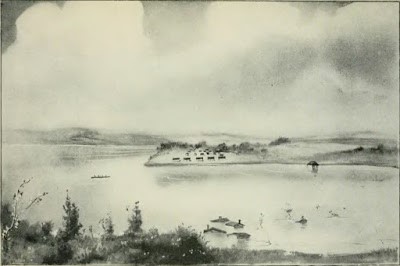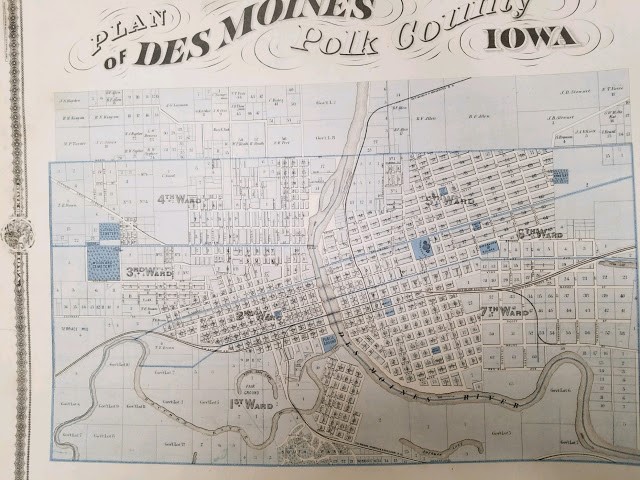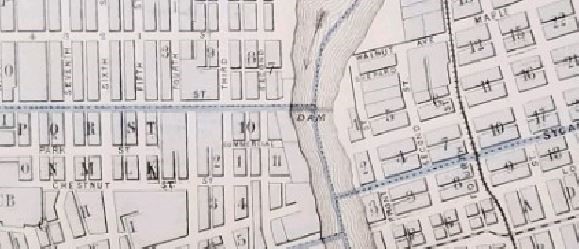Reverend John Linn
One woman's amazing story of floods, land, dams and confusion - A success story.As a researcher and historian, I know the trials and tribulations of converting a family "story" to fit the facts. Below is the wonderful successful ending to one of those searches. I am thrilled that I was able to help, even though I have never lived in Des Moines, and had to convert my mother's stories of her father's employment to help.
Our story begins for me with an email from Diane Young, a blogger & genealogist researching her gg-uncle, and her original email to me:
"I've been writing a blog this year which has finally been the catalyst for some family members to become as excited about my 40-year hobby as I have been. One of my nieces asked if I could do more research on a family story that our great-great uncle John Linn could have bought a portion of Des Moines and turned it down because he thought it was too expensive. As you know, it's hard to prove when someone DOESN'T purchase land. But today I was looking through the papers I have on him and read through a biography of his life that was printed, I believe, in the Dayton Review in the early 1900's.
And it DOES mention that he worked for a Mr. Z Hall, building a dam across the Des Moines river in Des Moines. Mr. Hall offered to sell John Linn 80 acres of land on the hill west of the dam for $320 that he could pay off in both work and wages. This diary clearly says that John Linn turned it down because the hill had no "charms".
So what I'm trying to find is where this dam would have been built in 1851-1852, maybe a photo, but some sense of where it was in Des Moines. I've been googling like crazy, looking at Polk County and the IGS sites and see nothing that might help and no one who does lookups on something this specific."
From here on, in her own words, is Diane's story:
Chapter 1
Family stories that are handed down for generations give us a richness of a person's life that almost always contain elements of heroism or fame. But they also can be completely false. When I talk with genealogy "newbies," my advice is that there is usually a grain of truth in the story but to be wary of accepting the story as complete.
One of my blog readers brought up a family story, one that many of us have heard. It goes something like this: John Linn, Gus Linn's brother, had an opportunity to buy property in what is now Des Moines, Iowa, and turned it down because he thought it was too expensive. I'll do my best using what we have and a bit of additional research to determine the veracity of this family story. But before we start, I want to say that my answer is somewhat incomplete but is the best I can do without reading several books about Polk County and Des Moines history, visiting the Iowa Genealogy Society or Historical Society, hiring a professional genealogist, or having a primary record in my files. Clearly there would be no official record of a land purchase that never happened.
I have a 17-page, single-spaced, typewritten "John Linn Diary" in my possession. Perhaps some of you do, too. As a diary, one would think it would have been written by John himself, but it is not. John is talked about in the third person, and the narrative reads more like a biography. The diary itself is not dated, but it was printed in its entirety in the Dayton Review over a 9-week period in April and May of 1891. The first installment appeared in the April 2, 1891, edition of the newspaper. The introduction to the series indicates that "With this introduction and no other apology than a confession of our inability to do the subject justice, we write the biography of Rev. John Linn." It was signed by the editor of the Dayton Review, J. G. Durrell.
On page 14, we see the reference to a potential land purchase. To set up the story, John's first wife, Brita, had died shortly after giving birth to their second child, Mary, on August 30, 1853.
John received an offer to "work in building the dam across the Des Moines river at Des Moines; and engaging Mrs. Jacobson [a neighbor] to take care of his home and children, he went down and secured work on this job at $13.00 per month. His employer, Mr. Z. Hall, was so well satisfied with him that he tried to induce him to stay with him, offering to sell him 80 acres of land on the hill west of the dam for $320 and giving him the privilege of paying for it in work, one half of his wages to be paid in cash and the other to go toward the paying for the land. Mr. Hall was a very sanguine man and assured Mr. Linn he was offering him an opportunity to secure an independent fortune; that the state capitol would someday be located in Des Moines and that railroads would be built there. Mr. Linn was incredulous. To him those barren hills from which Mr. Hall had taken timber for his dam and from which the garrison had built their huts and supplied themselves with fuel had no charms. He could not see the advantages at Raccoon Forks that would cause the removal of the state capitol there, or that would make her the commercial metropolis of a great state; and even if a big city should be built there whose rugged hills were not desirable for business or residence. To him the beautiful level bottom where he had chosen a home was a much better place than that recommended by Mr. Hall. He rejected the offer but Mr. Hall's prophecy has long since been fulfilled, and that eighty acres today is covered with magnificent residences and adjoins the heart of the city."
And so, perhaps there is some truth to this story. But where was the dam built in 1852-3? That would help pinpoint the hill to which the diary refers.
In 1851, torrential rains hit Iowa. To date, it is the highest recorded rainfall ever in the state: 74.5 inches in about a three-month period. You can imagine the devastation along the rivers in Iowa, trees downed, topsoil washed away, mud everywhere, and crops and entire towns destroyed. The Des Moines River, from the Mississippi to present-day Des Moines, as well as the Raccoon River tributary, were no exceptions to the flooding.

Drawing of the Des Moines River flood 1851
But by 1852 and 1853, people were once again looking at ways to improve the juncture of these rivers and to increase navigation to other parts of the state through a series of dams and to rebuild the town that would eventually be the capital of Iowa. John Linn was just one of many men hired to help with the necessary labor.
We think of Des Moines today and wonder where the dam that John worked on was and where the land that was near that dam would have been located. I cannot say with 100% certainty. But it appears to me that the dam was near where the present-day Wells Fargo Arena is, and the land John was offered was on a nearby hilly area which historically was called "Sherman Hill." (Today it is bounded roughly by 15th Street, Woodland Avenue, Martin Luther King Parkway and School Street.) The Hoyt Sherman Place, built in the 1870s, was built on that hill overlooking the city.
The exact locations might be a bit different than stated above, but I will leave that to others to review. The second important part of the question is "What was John thinking to turn down an opportunity to buy land in Des Moines?"
Here are my thoughts: We often assume that what we see today is what was evident in the past. And that's just not true. I thought that John had turned down an opportunity to buy prime land in the heart of Des Moines, but I no longer believe it is that simple. When he was offered the land, it was unattractive, floods had taken the trees, the topsoil, and left mounds of mud. How could John, or any other rational-thinking person, believe that the land along the river would EVER be valuable OR that Des Moines would become the capital? So John's decision at the time was a safe, reasoned decision. He was not willing to buy flooded land and take that risk with his two young daughters to raise. It would have been foolish at the time to buy it, knowing that Mr. Hall wanted half of John's wages paid in cash and the other to go toward paying for the land. John had gone to Des Moines, away from his two young daughters, to make money so he could return to them with money to feed, clothe, and house them, not to take a giant risk that might not have paid off in the end.
To whom then did Mr. Z Hall sell the land? Maybe to Hoyt Sherman. Maybe Mr. Hall had to hold the land, and perhaps he went bankrupt or developed the land itself. I've not found Mr. Hall in census or city directory records, and so I'm unable to tell exactly what happened with the land.
I'm not sure if my research and speculation will satisfy everyone. Below are links to several historical online papers and books that might help those who want to know more about the flood and early Des Moines or still question John Linn and his decision. I would welcome comments and thoughts that you have.
For me, I can respect that John did not take such a risk that could have put his family in jeopardy. As it turns out, after completing his employment on the dam, John then went back to Boone County to raise his two daughters, marry his second wife, Sarah (who, by the way, was the widow Mrs. Jacobson who was tending John's children while he was in Des Moines), raise her two sons, and have 5 more daughters with Sarah. He became an esteemed minister and bishop. I'd say he ended up having a pretty good life.
Weaver, James B., The Story of the “Des Moines River Lands,” The Annals of Iowa. State Historical Society of Iowa. Volume 18, No 6. 1932. 420-433. Des Moines River Lands
Hubler, Dave. "Des Moines River Navigation; Great Expectations Unfulfilled." The Annals of Iowa. State Historical Society of Iowa. Volume 39, Number 4. Spring 1968. 287-306. Des Moines River Navigation
Transportation in Iowa: A Historical Summary. Early Transportation in Iowa before Railroads. Early Transportation Before Railroads
Sherman Hill Historic District Sherman Hill
Chapter 2
One of the parts of my genealogy hobby I've enjoyed over the years is the camaraderie there is among family researchers, no matter what the level of expertise. Everyone has something to add; everyone has a photo or story or first-hand knowledge to add to the family history.
I've been fortunate over the years to find people descended from the siblings of Olof Olofson, to have exchanged information with people descended from the Linns, to have found people willing to do a look-up in a local library or archive for me, often at no cost. Just to be helpful. And I've been sent copies of photos that I never would have had without the generosity of other people.
And sometimes, one story, one ancestor, can inspire a person to find that bit of information or to follow up on a person's life, to find their grave, or a photo, or a land record, or a will. I've truly enjoyed having people pass in and out of my life, sometimes for just a brief time to exchange or answer a question. And a few people have become friends.
The John Linn family story post from 2 weeks ago inspired additional help from two sources, my brother Myron, and a webmaster for the Polk County IAGenweb site.
I first corresponded with the webmaster a couple of weeks ago, asking if she might know where the dam would have been built in 1852-53 or where the hill might be located. This was a part of her answer: " I'm wondering if the hill in your records is Sherman Hill where Iowa Methodist Medical Center is.... It could also possibly be where Woodland Heights and Woodland Cemetery are."
She sent a link to google maps where she thought the dam would have been located, and it turned out to be at the end of Center Street. This was the impetus for my looking more closely at the area, learning about the flooding and then the need for dams at various points along the Des Moines river. Looking more closely at the maps led me to follow Center Street west where it became clear that Sherman Hill might just be the hilly area referred to in the land offer to John Linn.
That was my best guess for the blog two weeks ago. And then, entered Myron.
He works with an attorney who has a map of Des Moines from 1871 hanging on his wall. Below is a copy of that map:
In case you cannot enlarge or see the dam itself, I've cropped a portion of it and added it below where the "dam" is clearly marked.
To the west of the Des Moines River and Center Street Dam, Center Street would have run through the middle of Sherman Hill, a hilly area of Des Moines where, in the 1870's and later, large, stately homes were built, just what Mr. Z. Hill had said would happen.
Area on left designated as Sherman Hill with Center Street cutting through, originating in the 1800's at the Des Moines River
With this additional help, I feel more certain that the dam John Linn worked on was, in fact, the Center Street Dam, and the land he was offered was located in Sherman Hill, not far west of the dam.
I love being a family history detective, and I'm so very grateful for the help I've gotten over the years to find more information about our ancestors. If you have a piece of family history, no matter how small, no matter how insignificant you think it might be, will you please share it? A copy. A photograph. A letter or will. A postcard or odd piece of china. All of it is a hint. Every item is a piece of the puzzle. And I promise to share what I have through these blogs.
Copyright © 1996
The IAGenWeb Project
IAGenWeb Terms, Conditions & Disclaimer



